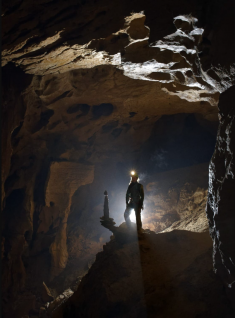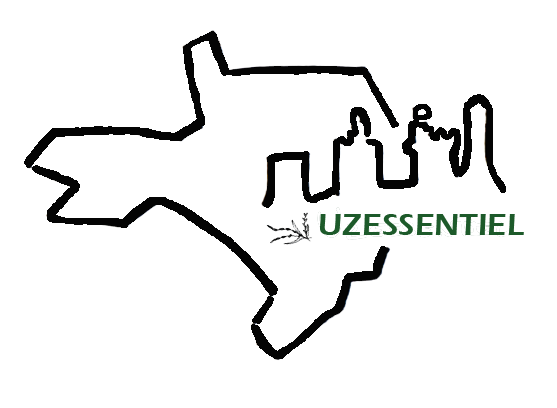Journey to the centre of the earth with the Comité Départemental de Spéléologie du Gard
- Par nbesse
- Le 12/01/2023
- Dans Living in Uzès and around
FR - The Comité Départemental de Spéléologie du Gard, linked to the Fédération française de spéléologie, has been leading its 150 members and 30 or so juniors, into the cavernous places of the department for over 60 years.

Its programme throughout the year leads to the discovery of the underground world whether it is "natural or artificial" and to canyoning sessions in total harmony with the environment.
The Comité on a daily basis
Collaborating with the departmental authorities, which allows us to be recognized by the department, our association links all the caving groups of the Gard (a little bit less than 10 - Bagnols-sur-Cèze, Nîmes, Brignon, Alès...) and the caving school of the Gard (EDS 30). Along with the protection of the environment, such as our actions for depollution, the Comité Départemental de Spéléologie du Gard can manage missions of protection of dangerous cavities or to be preserved.
What is Spélimages?
It is the connexion between the image and the caving film, whose sixteenth edition - and the very first in 3D, was held last November.
Another unknown aspect of the speleologists' life concerns the caving rescue interventions, carried out in collaboration with the firemen of the GRIMP (group of intervention in perilous environment) with the volunteers of the Comité intervene. All the members can take part to these caving rescues, with a monthly training. The members participating can take part to intervention in case of emergency (the last intervention of this kind took place in Lozere, a few years ago).

Good to know: The FFS (French Federation of Speleology) is the only sports federation which organizes rescue in its activity, in close collaboration with the GRIMP of the firemen in the Gard, the PGHM or the CRS of mountain in other departments.
The FFS can have to mobilise up to several hundred volunteers, trained by the French caving rescue, on a single rescue.
All members of the Federation can take part in these caving rescues, which organise one training session per month.
The meetings of the Comité
Every year in September/October take place the national days of speleology. Open to all, this caussenard gathering, welcoming cavers from all over France, is organised every 4 years between the Gard, the Hérault, the Aveyron and the Lozère, in a selected cave.
Cradle of speleology, let us remember here the memory of Edouard-Alfred Martel, the father of French speleology, the Causses are also one of the high places of the practice of this captivating activity.
Hundreds of cavers from all over France attend this Causses gathering, the last of which took place in Bramabiau, in Lozère last year. In 2024, it will be the turn of the Gard department to organise this event.
The activities of the Comité are not limited to discovering the Gard caves. Perfect professional partner to scientific research, promotion or teaching of speleology, the Comité organizes excursions for everyone, as it was the case last December 20th in Méjannes-le-Clap with the members of the MJC, creating a unique link with the population of the department.
Numerous activities are programmed during the year too, such as was the excursion, last year, with the college of La Grand-Combe, and now with the college students of Lou Redonnet in Uzès, within the framework of school sports under the patronage of the UNSS, the French National Union of School Sports.

Caving: a sporting adventure at the centre of the earth!
"The natural galleries formed by water over time are precious testimonies of the past. The subsoils shelter fantastic mineral decorations; they contain numerous geological, environmental or even prehistoric manifestations which are an important source of information on our ecosystem and our history" (CDS 30).
Discovery and challenge are the main motivations of cavers, who sometimes travel kilometres in the galleries and descend to several hundred metres, with the hope of making new discoveries.
Caving does not fear winter as the underground world is maintained at a temperature of 14/15 º throughout the year. Moreover, the karstic plateau of the Gard makes it a region particularly well "equipped" with caves and avens that can be explored on a regular basis, duly accompanied by an experienced caver. It has to be known that one should be very careful with caves located at the level of a river, as there is a risk of flooding.
The deepest cave in the Gard is undoubtedly the Pas de Madame cave in Sumène.
It is 350 m deep and takes between 10 and 15 hours to explore.
The little caves can be visited in 1 to 2 hours, while others can take a minimum of 10 hours to explore.
The youngest, between 6 and 8 years old, can access the caves in the company of a state-certified speleologist, as is the case for the small cave near Dions, also known as the baume rousse or the champignonnière (mushroom farm).
The term speleology comes from two Greek words "spelaion" (cave) and "logos" (science) (CDS30)
The approach to the "geological and hydrogeological terrain as well as the zoological, palaeontological and archaeological discoveries" allows a better understanding of the world around us, inciting reflection, particularly with regard to the safeguarding of historical heritage and the fight against pollution.
Supervised by experienced cavers, and only in this context, each outing is an enriching expedition.
What about canyoning?
Known for some years now, as it is the case in Ardèche and Lozère, canyoning has become one of the spearheads of the activities of the Comité Départemental de Spéléologie du Gard, in collaboration with Uz'Escalade.
The precursors of canyoning? Edouard-Alfred Martel and his colleague Louis Armand during their numerous expeditions (the cave of Aven Armand and its famous forest of 400 stalagmites bears the name, explored in 1897 in the company of E.A. Martel and Armand Viré, inventor of biospeleology).
Indicated for participants over 12 years old, canyoning and its "waterfalls, basins, gorges, vertical walls..." is the promise of a beautiful day trip.

Underground diving
As far as underground diving is concerned, it is aimed at the most experienced speleologists, generally already trained in sea diving, who go into "totally submerged galleries, impossible to go through with traditional means". Strong sensations are guaranteed towards the siphons which sometimes end the explored underground networks.
"It is the underground divers who explore the completely submerged networks
and thus extend the field of discoveries" (CDS30)
In the department, we count no more that 4 or 5 underground divers who can intervene in rivers as well as lakes, and to check if there are exits to these water arrivals...
These last explorers practice a discipline of the most intimist specifies Michel Serfati. Sometimes initiations take place in a small lake, without going down deep, because diving as such is reserved for an elite, using a complete equipment, such as the Ariane wire, the altimeter, etc.
Caves and other cavities in the Gard
Knowing that the explorations depend on the level of each participant, the Grotte claire of Méjannes-le-Clap is one of the ideal place where to start. It allows you to fly over a wide range of what caving promises: prehistory, paleontology (you can see the skeleton of a prehistoric ibex from the ice age). On the other hand, the Grotte claire is very playful, with a zip line, a rope passage, for a trip of about 3 hours.
An overview of the caves and cavities?
The Gard department is full of hundreds of caves of different lengths, some of which are known by cavers of all over the world.
Three sectors of the Gard are particularly rich in caves: the Gardon gorges (for example the cave of the dam, of Yerle), the Céze gorges and the west of the department, from Saint-Hyppolite-du-fort (among others, the Pas de Madame cave, the Fage cave, the Coutal cave, the traversée des Calles, in the aven de Bez) to Le Vigan.
On the plateau of Méjeanne-le-Clap, we find the aven du Camelié, the traversée de l'aven Grégoire, the grotte des Fées, the aven des Pèbres, the aven des oublis, the grotte claire (see above and on the Facebook page of the CDS 30 the small topo on the outing of the schoolchildren at the end of November), the aven des trois trous (another outing of the CDS 30)...
Thanks to Michel Serfati for his collaboration to this article and the visuals transmitted.
The right address : Comité de Spéléologie du Gard (CDS 30). Tempted to try it ? Contact Michel Serfati (michel.serfati@cds30.fr) or by phone at 06 89 56 96 22, contact@cds30.fr, the facebook page.
The Caving School (EDS 30) organises throughout the year activities every other Saturday for small groups of young people, between 14 and 22 years old, as well as camps during the school holidays.






